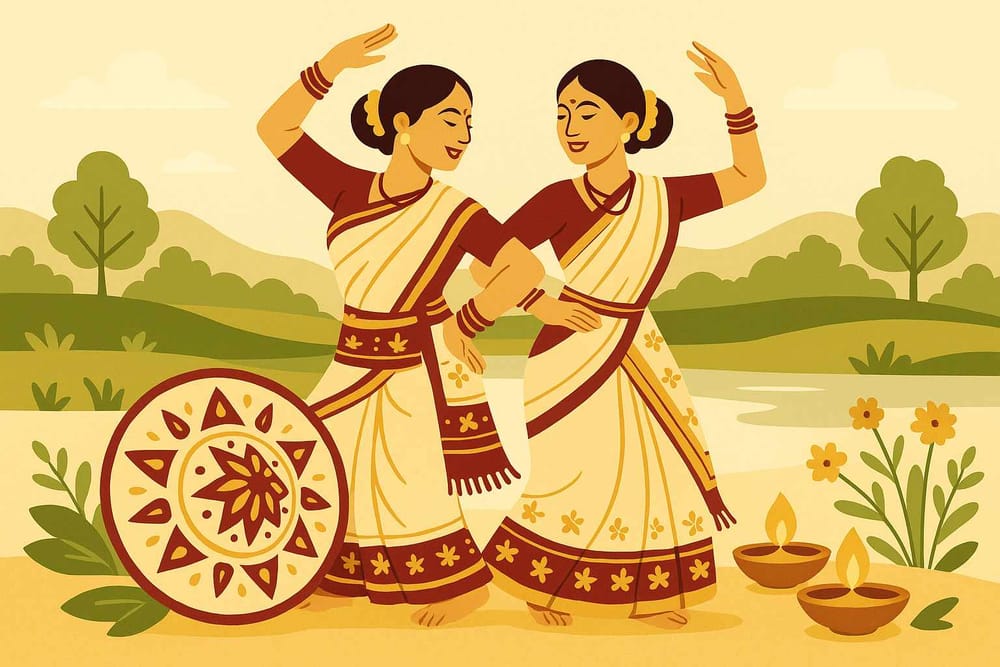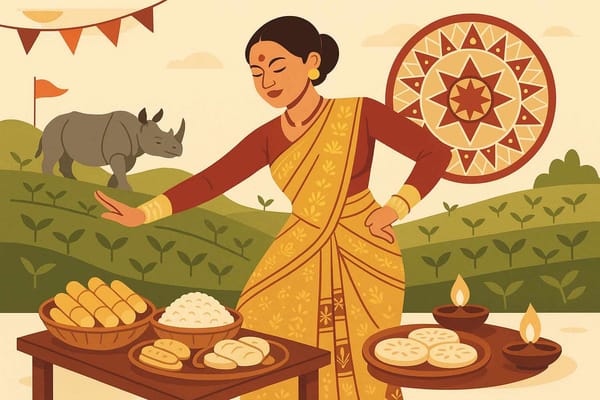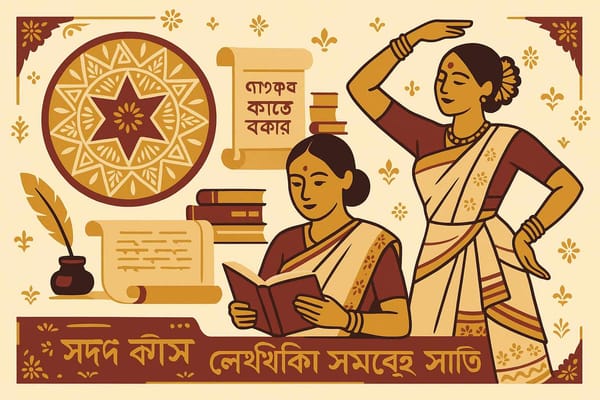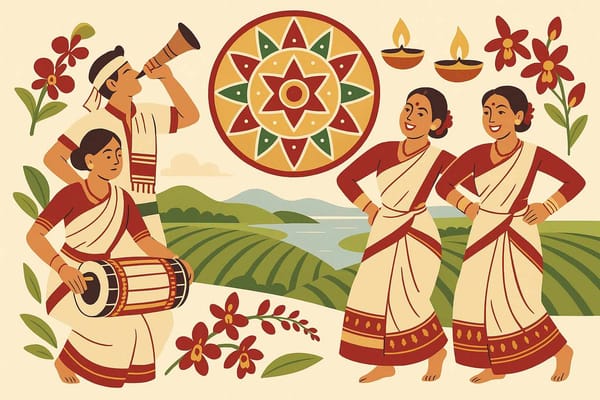
Assamese Culture-Traditions, Arts, and Heritage: An Exploration
Imagine a land where the mighty Brahmaputra river charts its course, where rolling hills are draped in the soft green of tea gardens, and where the air hums with the rhythm of looms and festive dhols. This is Assam, a land that doesn't just exist on a map but lives and breathes in its vibrant culture. It’s a place where every festival, every piece of silk, and every ancient stone tells a story. Come, let’s take a walk through this beautiful world and understand what makes the Assamese identity so special.
The Heartbeat of Assamese Traditions
In Assam, tradition isn't just something you read about; it's a way of life, a warm embrace you feel in the everyday. A perfect example is the Gamosa, a simple handwoven white cloth with red borders. But it’s so much more than a cloth. It’s a symbol of respect, a token of love, and a warm welcome offered to guests. It’s an essential part of every ceremony, carrying with it the blessings and warmth of the people.
The spirit of Assam truly comes alive during its festivals. While many celebrate important events, none capture the state's essence quite like Bihu. It is the most cherished festival, celebrated three times a year to honour the seasons of agriculture. Rongali Bihu in April marks the Assamese New Year with an explosion of joy, dance, and music. Then comes Kati Bihu, a more sombre occasion of prayer for the protection of the crops, and finally, Magh Bihu in January celebrates the harvest with community feasts and bonfires. Bihu is not just a festival; it's the rhythm that binds the community together.
Spirituality is deeply woven into the cultural fabric here. On the Nilachal Hill in Guwahati stands the revered Kamakhya Temple, a powerful Shakti Peeth. This sacred site draws devotees from all over, especially during the Ambubachi Mela, a unique festival celebrating the earth's fertility. The state's diverse population also means you'll hear the melodious blend of languages like Assamese, Bodo, and Bengali, each adding its own flavour to the region's rich traditions.
The Vibrant Canvas of Assamese Arts
The artistic soul of Assam is colourful, expressive, and deeply moving. The traditions of music and dance are not just for performance; they are expressions of devotion and joy. The Sattriya dance, for instance, is a classical art form that originated in Vaishnavite monasteries called Sattras. It’s a form of storytelling that feels like a moving prayer, with graceful movements narrating tales of faith and mythology.
In stark contrast is the energetic and infectious Bihu dance. Performed by young men and women in traditional attire, its lively steps and fast-paced rhythm capture the pure happiness of the festival. This beautiful expression is a cornerstone of how folk music and dance define culture. The sounds that accompany these dances are just as unique, with the sharp, melodic tune of the pepa (a pipe made from buffalo horn) and the powerful beat of the dhol creating an unforgettable atmosphere.
Echoes from the Past: Assam's Rich Heritage
To truly understand Assam, one must listen to the stories its heritage sites tell. These are not just old buildings; they are keepers of history. The Rang Ghar in Sivasagar, often called Asia's oldest amphitheatre, stands as a proud reminder of the Ahom dynasty. You can almost hear the cheer of the crowds who once watched games and events from its stands. Nearby, the Talatal Ghar, a palace with secret underground passages, speaks of the architectural and strategic genius of its time.
Assam's heritage also includes natural wonders that are deeply intertwined with its identity. Kaziranga National Park, a UNESCO World Heritage Site, is a sanctuary for the magnificent one-horned rhinoceros and a testament to the state's love for nature. Then there is Majuli, the world's largest river island, a centre of Vaishnavite culture where ancient art forms are still practiced in its peaceful Sattras.
A Taste of Assam: The Culinary Heritage
You can't talk about Assamese culture without savouring its unique cuisine. It’s simple, flavourful, and deeply connected to the land. The food here is known for its minimal use of spices and its focus on fresh, local ingredients. A classic meal often includes Khaar, a unique dish made with an alkaline extract and vegetables or fish, which has a distinct, earthy taste.
Another beloved dish is Masor Tenga, a tangy fish curry that is both comforting and refreshing. During festivals, no home is complete without Pitha, traditional cakes made from rice flour, jaggery, and coconut. They are little bites of happiness, shared among family and friends. The food of Assam is an experience in itself, offering a delicious glimpse into the local way of life.
Crafted by Hand, Cherished by Heart: The Legacy of Handicrafts
The crafts of Assam are a beautiful reflection of the people's skill and their sustainable relationship with nature. Exploring these crafts is a wonderful way to connect with the local culture, and many are now available online, bringing a piece of Assam right to your doorstep.
- Weaving and Textiles: Weaving is not just a craft here; it's a legacy passed down from mothers to daughters. Assam is world-famous for its silks, especially the lustrous, golden Muga silk, which is naturally durable and beautiful. The traditional two-piece dress for women, the Mekhela Chador, is a masterpiece of this weaving heritage.
- Bamboo and Cane Craft: Often called the 'green gold' of Assam, bamboo is used to create an astonishing variety of items. From sturdy furniture and beautiful baskets to the iconic Jaapi (a traditional conical hat), the craftsmanship showcases how utility and artistry can go hand-in-hand.
- Bell-Metal and Brass Work: In areas like Sarthebari, artisans have been crafting exquisite items from bell-metal and brass for centuries. The glistening xorai (a traditional offering tray) and other utensils are not just household items but symbols of Assamese culture and fine craftsmanship.
Exploring Assam is about more than just sightseeing. It’s about feeling the rhythm of the Bihu dance, savouring the unique flavours of its food, and appreciating the timeless beauty of its crafts. It's a journey into the heart of a culture that is warm, resilient, and deeply inspiring.
Just as Assam’s traditions are lovingly preserved, so is the vast ocean of India's spiritual literature. If your journey into Assam’s heritage has sparked a desire to explore the spiritual heart of India further, Bhaktilipi is here to guide you. We believe in keeping these timeless stories and devotional texts alive for today's generation.
About Bhaktilipi
© 2025 Bhaktilipi – Crafted with devotion. Bhaktilipi is a digital space dedicated to preserving, reimagining, and sharing timeless devotional literature and stories from diverse regions and languages. We aim to make this sacred knowledge accessible to everyone, connecting ancient traditions with modern readers.
Why Bhaktilipi?
Bhaktilipi helps you explore the rich cultural tapestry of India, including the profound traditions, arts, and spiritual practices like those found in Assam. By preserving authentic devotional texts and stories, we offer valuable insights into rituals, customs, and the very essence of spirituality.
Stay Connected
Discover more soul-stirring content by subscribing to our newsletter. Follow us on social media for your daily dose of inspiration:
Join us in celebrating devotion through knowledge.
A passionate group of people dedicated to preserving India's knowledge of Dharma, Karma, and Bhakti for ourselves and the world 🙏.
Comments
Related in

Exploring the Depths of Assamese Culture- Beyond the Known- A 2025 Perspective
There's a certain magic in the air of Assam, a scent of rain-soaked earth from the sprawling tea gardens mingling with the distant, soulful tunes of a Bihu folk song. It’s more than just a place of stunning natural beauty; it's a land where every

Sadou Asom Lekhika Samaroh Samiti-Traditions Defined
There's a certain magic in the stories our grandmothers tell us, isn't there? In Assam, this magic isn't just confined to homes; it's a living, breathing movement, nurtured by a powerful collective of women. I'm talking about the Sadou Asom

Assamese Culture-Explore Rich Heritage: An Insight
There's a certain magic in the air when you think of Assam. It's in the morning mist that hangs over the sprawling tea gardens, in the powerful flow of the mighty Brahmaputra, and in the rhythmic beat of the Bihu dhol that you can almost hear
